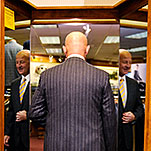BUFFALO — It was the proverbial melting pot, festive, aromatic and polyphonic. There were young hipsters (identifiable by their wool caps and archaic facial hair) and local homesteaders, along with settlers from Myanmar, Bhutan, Pakistan and Africa, to name just a few of the cultures represented at this once-blighted city’s annual auction of foreclosed properties. Would-be homeowners and property moguls huddled over the listings for more than 4,300 parcels of vacant lots and houses, their hoped-for choices highlighted and starred.
Small-Scale Developers, Big Dreams

On Massachusetts Avenue, two houses owned by Joseph Galvin, an early microdeveloper. More Photos »
By PENELOPE GREEN
Published: November 6, 2013
Multimedia
Follow Home on Twitter
Connect with us at @NYTimesHome for articles and slide shows on interior design and life at home.
Bernice Radle and Jason Wilson, both 27, brandished their own sheaf of marked-up listings. They were clearly old hands, hopping up to greet friends and mingling as if at a cocktail party. “Last year was so intense,” Ms. Radle said, “we had to go home and take a nap afterwards.”
This was their second auction; at their first, they bought a vacant lot ($500) and three century-old houses ($66,000), holdings to which they later added an 1870s cottage purchased directly from the owner for $1 after convincing him that it would be cheaper to let them assume his debts and fees (about $5,000) than to spend triple that amount razing the place.
Passionate and preservation-minded, Ms. Radle and Mr. Wilson both have degrees in urban planning and are emblematic of a particular wave of development here. Buying on a small scale, they and their peers are perhaps best described as microdevelopers, rehabbing derelict properties to rent and perhaps eventually sell in an attempt to save houses from demolition and preserve a neighborhood or two. In so doing, they are attempting to shore up the city’s long, slow decline since the population and jobs began leaking away more than a half-century ago. One group, the Farmer Pirates, bought 22 vacant lots that they turned into farmland and a composting station.
E. Frits Abell, 41, an entrepreneur who has worked in Boston and New York City, has bought three properties on the same street and plans to open a coffee shop and a branding agency. (He has already started a successful art fair called echo.) Countless others are buying one or two properties and wrestling them into a habitable state, no joke when your capital is mostly sweat equity and optimism.
As Mr. Abell said recently: “The rents are too low, and the numbers don’t really add up. It’s a labor of love.”
These activist microdevelopers are different from the slumlords and absentee owners who buy properties in bulk, rent them to vulnerable communities and spend nothing on refurbishment or services, compounding Buffalo’s woes.
The city’s vacancy rate is still above 15 percent, as it was in 2000, the highest in the nation for cities with populations of more than a quarter million, according to the Partnership for the Public Good, extrapolating from the 2010 census. Since 2007, the city has been pursuing a policy of demolishing the thousands of abandoned houses here, nearly 70 percent of which were built before 1940, making Buffalo’s housing stock the oldest in the country. But this barren and still lovely landscape, with its Olmsted-designed parkways and wide, radial streets gaptoothed with lone, crumbling houses, is appealing to young urbanists like Mr. Wilson and Ms. Radle.
Mr. Wilson, who grew up in a suburb nearby and is the director of operations at Preservation Buffalo Niagara, said: “Our generation never saw the decline. We don’t remember the old restaurant that used to be on some corner. We see a vacant lot, and we see opportunity.”
Ms. Radle added, “We see bocce!”
Bocce is tactical urbanism, she explained to a puzzled reporter: “It introduces people to the neighborhood; it doesn’t cost a lot of money or need much infrastructure. It’s not too loud.” She and Mr. Wilson plan to put a bocce court on the vacant lot they bought last year.
The couple met two years ago, when they were organizing competing events for young professionals during a conference that the National Trust for Historic Preservation held in Buffalo, and discovered in each other a kindred spirit. “Jason said, ‘I want to buy houses,’ ” Ms. Radle recalled. “And I was like, ‘I want to buy houses.’ ”
Buffalove Development is the name of the limited liability company they’ve formed as property owners. For fun, they spend weekends with other members of Buffalo’s Young Preservationists, a group Mr. Wilson founded a few years ago, doing what they call “board-and-seals” of abandoned properties: boarding up windows and cleaning out refuse, mowing lawns and tar-papering roofs.
They have held workshops and tours in their own properties to illustrate the process by which others can buy abandoned houses. Last month, when Ms. Radle spoke at TEDxBuffalo, she held up a heart-shaped poster that read “Preservation Is Sexy,” as she explained the manifesto (preservation as social activism) that drives her and her peers. Perhaps inevitably, they are being courted by the producers of television reality shows.















